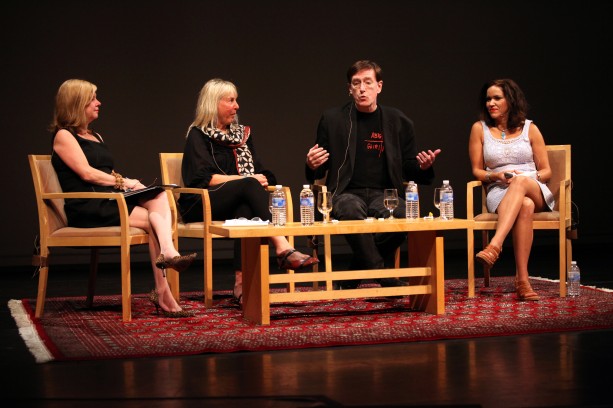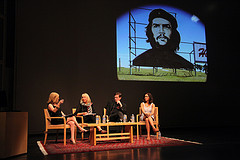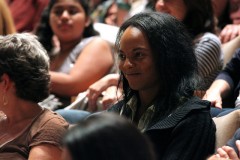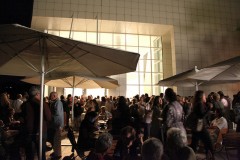
In the American imagination, Cuba is the land of Castro, cars, communism and cane (sugar), a place that offers an escape from the realities of history and the world.
But for three Americans who have devoted their lives to studying the island nation’s landscape, architecture, art, music, and history – and shared their work during a Zócalo panel at the Getty Center Thursday night – that American vision of Cuba is almost the very opposite of the truth. Cuba is different precisely because it offers no refuge from history.
 “There’s a topography of memory that is everywhere. You cannot escape history. It is there,” said Lillian Guerra, who studies Cuban history at the University of Florida. “If historical amnesia is a way of life for many Americans, remembering is life in Cuba. You have to remember. It’s what makes it such an incredible place to go.”
“There’s a topography of memory that is everywhere. You cannot escape history. It is there,” said Lillian Guerra, who studies Cuban history at the University of Florida. “If historical amnesia is a way of life for many Americans, remembering is life in Cuba. You have to remember. It’s what makes it such an incredible place to go.”
That history, Guerra and her fellow panelists noted, is visible on almost every surface in Cuba – and can be seen on the walls of the Getty. A Cuba exhibit now displays photographs from three distinct periods: the 1930s, the revolutionary period of the late 1950s, and the past decade.
Virginia Beahan, a panelist whose photos are part of the exhibit, told the standing-room-only audience in the Getty’s Harold M. Williams Auditorium that Cuba became her subject somewhat by accident. In the late 1980s, she inherited a house in Miami that had been built by her grandparents. But until she visited it, “I had no idea that the house was in the middle of Little Havana.”
Her time in the neighborhood made her curious about Cuba. She jumped at a chance to travel to the island in 2001, and knew she had found a photographer’s paradise.
“I was immediately struck by how visual everything was in the landscape,” she said, noting that signs and paintings were everywhere. “Things seemed fresh and immediate. History was literally written on every surface. On walls. On trees. Rocks spelling out slogans on the hillside.” She returned and photographed as much as she could – in part out of an awareness that the signs and trees and art she saw on so many Cuban surfaces “weren’t going to last,” given the dangers of hurricanes. And of politics.
 Another panelist, musician and writer Ned Sublette, a champion of Cuban music, described how Cuba’s history – as a port where people from all over the world stopped and mixed – has shaped the past 500 years of world music.
Another panelist, musician and writer Ned Sublette, a champion of Cuban music, described how Cuba’s history – as a port where people from all over the world stopped and mixed – has shaped the past 500 years of world music.
Peppering his historical narrative with a bit of instructive singing, Sublette demonstrated the influence of Cuba on all sorts of music-from African tribal beats to reggaeton, and from the Las Vegas cabaret show to the Beatles.
“Fidel, Raul, Camilo, Che,” he declared, listing four heroes of the Cuban revolution — Fidel Castro, Raul Castro, Camilo Cienfuegos and Che Guevara – whose rise predated, and perhaps prefigured, the rise of the Fab Four.
“Band of four guys with long hair,” he noted. “I’m not kidding.”
Guerra, the Florida-based Cuban historian, surveyed American depictions of Cuba – up to and including the popular video game “Call of Duty: Black Ops,” which allows players to go on secret CIA missions to Cuba (and try to do what the CIA could not: kill Castro).
“It’s not history that this game teaches,” she said. “It’s amnesia.”
Cubans don’t have the luxury of amnesia, she argued, because they aren’t buffeted from history by American consumerism and culture. “Americans discover in Cuba that it’s a dangerous place,” she said. “There’s no Wal-Mart in Cuba. There’s no place to hide from reality.”
 But that reality is diverse, as the eclectic conversation among the panelists – a photographer, musician and historian – demonstrated. Audience questions also reflected that eclecticism. The first part of one man’s two-part question was a detailed query about whether the U.S. should lift the embargo and establish normal relations with Cuba. The second part was, “Can you talk about Celia Cruz?” (Cruz is a famous Cuban-American singer.)
But that reality is diverse, as the eclectic conversation among the panelists – a photographer, musician and historian – demonstrated. Audience questions also reflected that eclecticism. The first part of one man’s two-part question was a detailed query about whether the U.S. should lift the embargo and establish normal relations with Cuba. The second part was, “Can you talk about Celia Cruz?” (Cruz is a famous Cuban-American singer.)
The night’s moderator, Olga Garay, executive director of the City of Los Angeles Department of Cultural Affairs, answered that the panelists agreed that the current U.S. policy of limiting contact between the two nations was counterproductive. Cubans and Americans need to know each other better because they have so much in common-more than just Celia Cruz. Guerra recalled that on one trip to Cuba she went to see Mel Gibson’s The Patriot, a violent epic of the American Revolution. The Cuban audience ate it up, convinced it was a “very Cuban movie.”
“Americans and Cubans are extremely idealistic. We have tremendous commitments to ideals. So do Cubans,” Guerra said. “We share this idea that we fight empires.”
Watch full video here.
See event photos here.
Read an essay by Cuban dissident blogger Yoani Sánchez here.
View a photo essay on Cuba in the American imagination here.
Read four experts’ takes on the Cuba’s future here.
*Photos by Aaron Salcido.




Send A Letter To the Editors